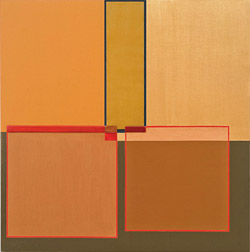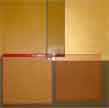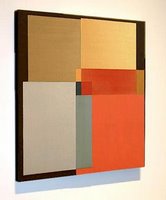Windows
“Wild Brushfire Set By Gary Edward Blum, Barbara Kerwin, Dennis Hollingsworth”
Peter Frank, May 28, 2008
 Barbara Kerwin, Window IX 2008
Barbara Kerwin, Window IX 2008
Gary Edward Blum and Barbara Kerwin concur on the hows and whys of laying down paint.
In his canvases Oakland-based Blum accrues layers of pigment and what seem to be notations pertaining to color,
determining a constant shifting in texture and tone, edge and hue, structure and thought.
He constantly juxtaposes crisp and rough contours in a curious but sensuous pictorial strategy.
Little brush strokes often align near the bottom as if Blum were sampling colors. Just as often, larger “chips”
of paint are arranged at or near the locus of the composition—seemingly attached with tape, a slightly corny but entertaining conceit.
A remarkably coherent, vibrant whole emerges from the sum of these clever parts. Local painter Kerwin employs many of the same techniques,
and is even more committed to a formal language based in geometry, but she seems to develop her work in the opposite direction, from the inside out.
Even though her rectilinear structures align themselves carefully with the edge of her panels, Kerwin composes them as if coaxing them out of the heart of the picture,
rectangles spiraling out and fixing themselves, somewhat off-center, with a surprisingly elusive compositional logic.
Ruth Bachofner Gallery, 2525 Michigan Ave., Bldg. G2, Santa Monica; Tues.–Sat., 10 a.m.–5:30 p.m.; thru May 31. (310) 829-3300.
For all their contemplative tidiness, Blum and Kerwin paint richly and sexily. So does Dennis Hollingsworth, but without the good manners.
Hollingsworth has covered his huge canvases with a wealth of oil pigments, bubbling and cascading as if spilling from a volcano or geyser.
Clots and rivulets of bright, contrasting color run up against one another, somehow never getting muddy. Hollingsworth’s lava comes from the rainbow.
There is something else, however, that makes these effulgences seem so much more reasoned, so much more visually and intellectually substantive,
than the faux-ab-ex vomitoria they might pretend to be: Every stream and globule maintains its discrete presence, holds its own in the painterly stew.
Hollingsworth is not mucking about; he’s actually composing his eruptions, emulating the sense as well as the force of nature.
Michael Kohn Gallery, 8071 Beverly Blvd., L.A.; Tues.–Fri., 10 a.m.–6 p.m., Sat., 11 a.m.–6 p.m.; thru May 31. (323) 658-8088.
“Gary Edward Blum
Barbara Kerwin”
April 19–May 31, 2008 at Ruth Bachofner Gallery, Santa Monica
Mat Gleason, 2008


 Barbara Kerwin, Window VII, III, IX 2008
Barbara Kerwin, Window VII, III, IX 2008
Geometric abstraction is far from en vogue these days, so much so that what was once the art world's mainstream is again radical in art world echelons. Ironically, geometric abstraction has maintained that position among the middle class, whose sensibilities it both offends and up-ends, since its inception a century ago.
The work of painters Gary Edward Blum and Barbara Kerwin share similarities and will complement each other. Both painters commit to the experiential and meditative nature of art without overt content. For years Barbara Kerwin has been a maverick manufacturer of the most sensuous, skin-like abstract paintings in Los Angeles. But instead of falling into a touchy-feely trap, Kerwin posits her textures in rigid geometric patterns. The effect is a soothing, cool humanism—rare in this genre still dominated by the Soviet-like sensibilities of Kasmir Malevich.
In her latest work, geometry is used to reflect on the centrifugal. The logical patterning of large-to-small takes the viewer from the edges of the piece into its center, where a darker section of the composition suggests destinations that are absolute, yet safe. Structurally echoing Mondrian through the filters of the post-modern, these pleasant paintings challenge us to mediate on the fact that we may have already arrived at our goal. A cynic might say, “Maybe this is as good as it gets,” while an optimistic Kerwin seems, in this work, to promise that we will remain happy since we so enjoyed our ride.
If Kerwin manages to find the lighter side of rigidity, Gary Edward Blum implodes the pretensions to perfection inherent in the geometric. He does this without losing the forms that imply structure and embody simplicity. The approach is an unfinished, unhurried approximation of where the picture may be going, complete with paint swatches meant to match various foreground and background shades. But the work is very much finished, a complete narrative of a meditative process that is fearless in that is leaves on display much of what an artist’s picture went through just to be with you here in the gallery.
Blum turns the conventions of abstraction inside out. He avoids cloying, cute colors in favor of beiges and creams that imply space. He abandons the rigid, but offers little evidence of the artist's hand as a god-like gesture of certain will. The paintings seem open to so much possibility, and yet they assert a rare aesthetic position: concretizing process without resorting to pattern. The artist embraces process as an artist's narrative. To make the passage of time spent painting the very subject of the painting is bold when every cliché of the last century is forgotten, or at least untried.
These two artists share a sympathy in wanting the simple, radical gesture of inclusion without the content of agenda to be art. Their work complements each other without treading on nuanced yet definite territory that each artist stakes out. Rigorous and satisfying, yet experimental, idiosyncratic and unique, these artists make grand pushes into abstraction's great undiscovered country.
“Barbara Kerwin Exhibit”
Robert Kingston, May 1, 2008

 Kerwin In front of Window X, Window XII
Kerwin In front of Window X, Window XII
Barbara Kerwin's exhibition of elegant and coolly formal abstractions opened recently in Santa Monica. In her earlier work Barbara used a more static grid format that was mostly powered by her lush use of [oil in high melt wax] paint and her sophisticated palette. In her more recent paintings however she employs a shifting grid format that allows for her strengths but creates a more dynamic and at the same time more playful outcome.
SEE: Accidental Video by Robert Kingston http://www.youtube.com/watch?v=PMnT9dVCIMo

